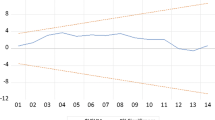Abstract
Iran experiences a high level of energy consumption which is threatening not only economically but also politically and environmentally. This study aims to estimate the relationship between the economic growth with the various kinds of energies, non-hydroelectric, renewable, non-renewable, and total energies in Iran during 1967–2012, using an autoregressive distributed lags (ARDL) model. The results show the ineffective relationship between the economic growth and energy consumption in Iran, considering non-hydroelectric energy, renewable energy, non-renewable energy, and total energy, one by one as the energy proxy. It implies the ineffectiveness of both the quantitative and qualitative deflationary policies over the energy sector. In another word, neither decreasing energy consumption nor changing energy portfolio affects the economic growth. Therefore, the policy makers are advised to formulate those policies which reduce the quantity of energy consumption or increase the segment of renewable energies in the portfolio of energy consumption because they do not lead to the considerable negative consequence on the economic growth, while they increase both the environmental quality and energy security.










Similar content being viewed by others
Notes
A department in the Central Bank of the Islamic Republic of Iran. Available from: http://tsd.cbi.ir/.
References
Apergis, N., & Payne, J. E. (2011). On the causal dynamics between renewable and non-renewable energy consumption and economic growth in developed and developing countries. Energy Systems, 2(3), 299–312.
Baer, R. (2008). The devil we know: Dealing with the new Iranian superpower. New York: Crown Publishers.
Boudria, J. C., Hordijka, L., Kroezea, C., Amannb, M., Cofalab, J., Bertokb, I., et al. (2002). The potential contribution of renewable energy in air pollution abatement in China and India. Energy Policy, 30, 409–424.
Central Bank of the Islamic Republic of Iran. (2016). Economic time series database, economic research and policy department. Available at: http://tsd.cbi.ir/.
Energy Balance Sheets. (2013). Iran Energy Ministry, in Persian. Available at: http://www.saba.org.ir/fa/energyinfo/tashilat/taraz.
Guivarch, C., & Monjon, S. (2016). Identifying the main uncertainty drivers of energy security in a low-carbon world: The case of Europe. Energy Economics. doi:10.1016/j.eneco.2016.04.007. in press.
Hossain, Y., Loring, P. A., & Marsik, T. (2016). Defining energy security in the rural North-Historical and contemporary perspectives from Alaska. Energy Research & Social Science, 16, 89–97. doi:10.1016/j.erss.2016.03.014.
Jafari, H. H., & Baratimalayeri, A. (2008). The crisis of gasoline consumption in the Iran’s transportation sector. Energy Policy, 36, 2536–2543. doi:10.1016/j.enpol.2008.03.014.
Mehregan, N., & Keramatfar, M. (2014). The effect of energy carriers prices on manufactured export in Iran, using panel data model. International Journal of Business and Development Studies, 6(1), 113–125.
Omri, A. (2013). CO2 emissions, energy consumption and economic growth nexus in MENA countries: Evidence from simultaneous equations models. Energy Economics, 40, 657–664. doi:10.1016/j.eneco.2013.09.003.
Omri, A., Nguye, D. K., & Rault, C. (2014). Causal interactions between CO2 emissions, FDI, and economic growth: evidence from dynamic simultaneous-equation models. Economics Modelling, 42, 382–389.
Pesaran, M. H., & Shin, Y. (1995). An autoregressive distributed lag modelling approach to cointegration analysis. In Econometrics and economic theory in the 20th Century (chapter 11, pp. 371–413). Cambridge: Cambridge University Press. doi:10.1017/CCOL521633230.011.
Radovanovic, M., Filipovic, S., & Pavlovic, D. (2016). Energy security measurement—A sustainable approach. Renewable and Sustainable Energy Reviews. doi:10.1016/j.rser.2016.02.010.
Statistical Centre of Iran. (2015). Iran. Available at: www.amar.org.ir/.
Taghavee, V. M., Aloo, A. S., & Shirazi, J. K. (2016). Energy, environment, and economy interaction in Iran with cointegrated and ECM simultaneous model. Procedia Economics and Finance, 36, 414–424. doi:10.1016/S2212-5671(16)30056-9.
Taghvaee, V. M., & Hajiani, P. (2014). Price and income elasticities of gasoline demand in Iran: using static, ECM, and dynamic models in short, intermediate, and long run. Modern Economy, 5, 939–950. doi:10.4236/me.2014.59087.
Taghvaee, V. M. & Hajiani, P. (2015). Environment, energy, and environmental productivity of energy: a decomposition analysis in China and the US. Second European Academic Research Conference on Global Business, Economics, Finance and Banking, 3–5 July 2015, Zurich, Switzerland. doi:10.13140/RG.2.1.4640.2001.
Wang, L., Xu, L., & Song, H. (2011). Environmental performance evaluation of Beijing`s energy use planning. Energy Policy, 39, 3483–3495. doi:10.1016/j.enpol.2011.03.047.
World Bank (2014). World Development Indicator. Available at: http://databank.worldbank.org/data/views/variableselection/selectvariables.aspx?source=worlddevelopment-indicators.
Author information
Authors and Affiliations
Corresponding author
Rights and permissions
About this article
Cite this article
Taghvaee, V.M., Mavuka, C. & Shirazi, J.K. Economic growth and energy consumption in Iran: an ARDL approach including renewable and non-renewable energies. Environ Dev Sustain 19, 2405–2420 (2017). https://doi.org/10.1007/s10668-016-9862-z
Received:
Accepted:
Published:
Issue Date:
DOI: https://doi.org/10.1007/s10668-016-9862-z



